Data is currently (subject to shutdown delay) at
https://data.giss.nasa.gov/gistemp/tabledata_v4/GLB.Ts+dSST.csv
or
https://data.giss.nasa.gov/gistemp/tabledata_v4/GLB.Ts+dSST.txt
(or such updated location for this Gistemp v4 LOTI data)
January 2024 might show as 124 in hundredths of a degree C, this is +1.24C above the 1951-1980 base period. If it shows as 1.22 then it is in degrees i.e. 1.22C. Same logic/interpretation as this will be applied.
If the version or base period changes then I will consult with traders over what is best way for any such change to have least effect on betting positions or consider N/A if it is unclear what the sensible least effect resolution should be.
Numbers expected to be displayed to hundredth of a degree. The extra digit used here is to ensure understanding that +1.20C resolves to an exceed 1.195C option.
Resolves per first update seen by me or posted as long, as there is no reason to think data shown is significantly in error. If there is reason to think there may be an error then resolution will be delayed at least 24 hours. Minor later update should not cause a need to re-resolve.
People are also trading
@Rhhgdd Getting 1.230 (1.215 without adjustment from own past errors).

That sharp drop at the end of the month seems to be from mostly Siberia and N. America:
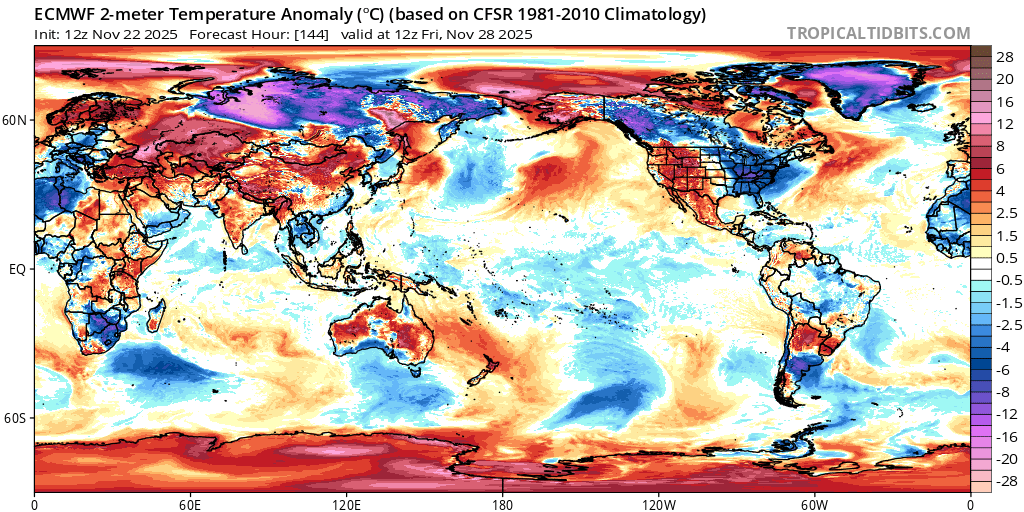
Looking at the forecast for December I do wonder if whether we will get another year where there isn't a proper dip/inflection for winter and it sort of flat lines like the winter for 2024-2025.
~
Nov data release date is scheduled for Dec 9 ... should have enough for a preliminary report by then based on the timing for the data this month, but even with sufficient coverage its still going to be a bit sparse data wise...
I note that the October data has shifted as of a few days ago now to a lower bin (1.1943) when they some more data for Bolivia and parts of Antarctica came in.
I don't know if we should expect a drip-drip of data again for areas that came late for October, or to expected those to make it next month on time. Based on the rate they have been going it doesn't seem likely NCEI will finish the upgrade in the next 2 weeks ((before the November report is released). A good deal of the mana again will seem to be made guessing what regions will make it into the data in time for the report and how much shift will occur...
banana
@Rhhgdd Even without the very end of the month still not in the medium range ensembles, the very end of the month looks to be a bit more uncertain than usual.
~
Regarding Alaska/NW Canada:
I can't say how large a contribution but it looks like from examining the synoptic scale from medium range forecasts, some of the warm anomaly in Alaska / NW Canada from the bump in temps over the next week (especially ending near the 21st) looks to be coming from warmer extratropical air advecting poleward from (frontal?) extratropical cyclones.
ECM/00Z EPS/00Z disagree about the synoptic situation of course at the end of the month with the jetstream arcing poleward in ECM creating a high pressure over Alaska (but EPS doesn't have any strong agreement that far out on such a speculative scenario).
From the 00Z ensembles... (very last day in medium range is GEPS/GEFS only thus higher uncertainty).

~
For the bump in the next couple days perhaps?:

and for the Nov 19-20th bump...
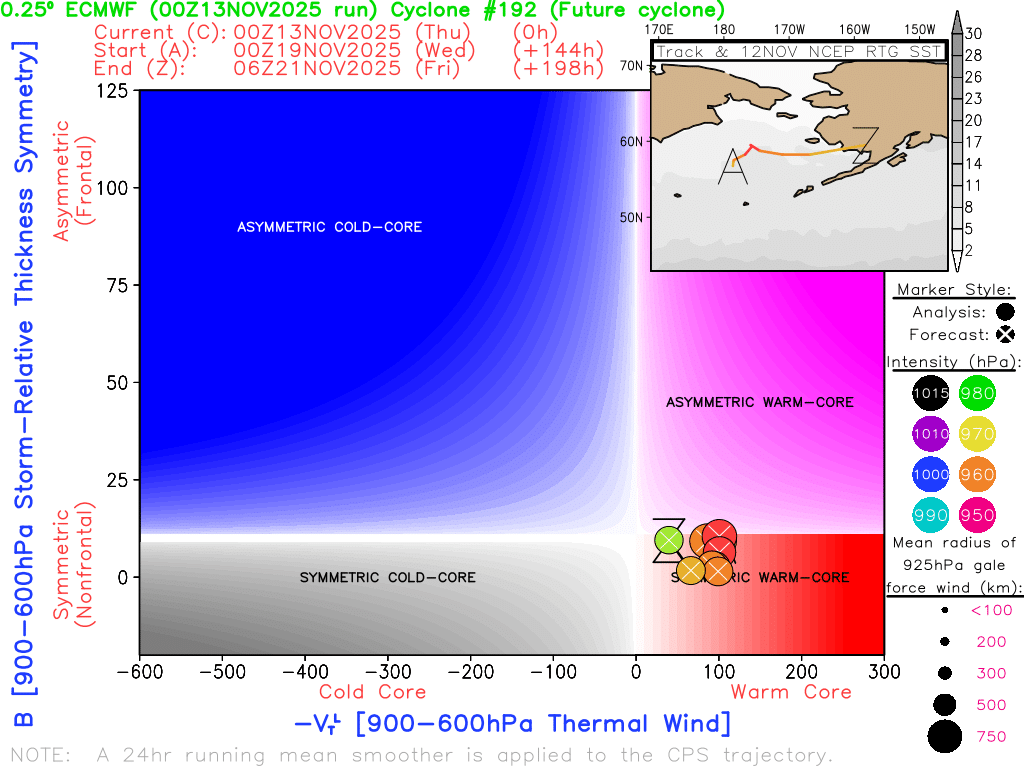
~ Edit (Nov 14):

~
For anyone that cares pivotalweather's (open) beta has finally made their site (more) usable as they now have a slider like tropicaltidbits that makes it so much better to quickly advance ...

~
Anyway based on the steep trend at the end of the month and some subjective expectation of above average uncertainty for it (i.e. the last week) I expect above average error from that period, so I'm flattening my bet now a bit.
~~~~~
~~~~~
I note also that there has been disagreement in the short term trend (last 4 days) of the center point predictions between the two notebooks I use (one with the higher variance per-ensemle debiased temps in the superensemble has trended upwards slightly, and one with the unbiased one which has lower variance has trended downwards slightly -- I usually rely on the latter though as the bias seems generally comparable).
~
The latter after all adjustments has a center point prediction of 1.246 C for reference.
~~~~
~~~~
I don't know if I've noted it but I switched a few months ago to referencing less dispersive distributions using my own empirical estimates of the super ensemble variance (i.e. not including the super ensemble member distribution's variance) along with some other measures to give a better subjective idea of the distribution (i.e. a statistical model, and one without any ensemble variance -- i.e. as if this was the ERA5 data after the month ends to cap the probabilities).
I.e. this is what it looks like (I also look at the trends in center point predictions from the two notebooks and agreement between them for some measure of confidence) (usually the middle one is the one I anchor my predictions to mostly (in bold), with the last of the three I also reference if I feel its overdispersive or if a one-sided bin looks to have too much of a contribution) (the rest I briefly look for agreement as a sanity check) :
From the unadjusted ensembles notebook (the one I reference as it has slightly less empirical variance):
Mean of Statistical, End-of-Month type (no ensemble forecast variance), and Estimated Variance
Bin Probability (%)
<1.095 5.9
1.095-1.145 9.6
1.145-1.195 19.1
1.195-1.245 27.7
1.245-1.295 21.7
>1.295 15.9
Mean of End-of-Month type (no ensemble forecast variance), and Estimated Variance
Bin Probability (%)
<1.095 6.6
1.095-1.145 5.0
1.145-1.195 10.9
1.195-1.245 27.0
1.245-1.295 27.5
>1.295 23.0
End-of-Month type (no ensemble forecast variance)
Bin Probability (%)
<1.095 0.0
1.095-1.145 0.5
1.145-1.195 9.2
1.195-1.245 39.6
1.245-1.295 40.4
>1.295 10.3
~
From the debiased ensembles notebook:
Mean of Statistical, End-of-Month type (no ensemble forecast variance), and Estimated Variance
Bin Probability (%)
<1.095 5.2
1.095-1.145 9.1
1.145-1.195 17.2
1.195-1.245 24.2
1.245-1.295 24.0
>1.295 20.3
Mean of End-of-Month type (no ensemble forecast variance), and Estimated Variance
Bin Probability (%)
<1.095 5.4
1.095-1.145 4.3
1.145-1.195 8.1
1.195-1.245 21.8
1.245-1.295 30.8
>1.295 29.6
End-of-Month type (no ensemble forecast variance)
Bin Probability (%)
<1.095 0.0
1.095-1.145 0.1
1.145-1.195 4.4
1.195-1.245 29.5
1.245-1.295 46.8
>1.295 19.3
Regarding people betting the lower bins up... I wish you luck (I would appreciate some cooler December weather):
~
Something that I failed to mentioned yesterday was that my impetus the other day for looking at the synoptic situation in the arctic was spurred by a lot of people on social media discussing the potential of a SSW in the Arctic around the end of the November (~Nov. 26). (This is something I did look at for quite some time but didn't mention in my post, for reasons below...)

Regardless of whether/how this (13+ day forecast) verifies, this still is far out with respect to how that uncertainty might translate into the synoptic situation (especially for Siberia and US/Canada) at the end of the month.
For instance, GEPS shows a Siberian high developing for the end of the month (~10 days or so) and a corresponding cold anomaly...
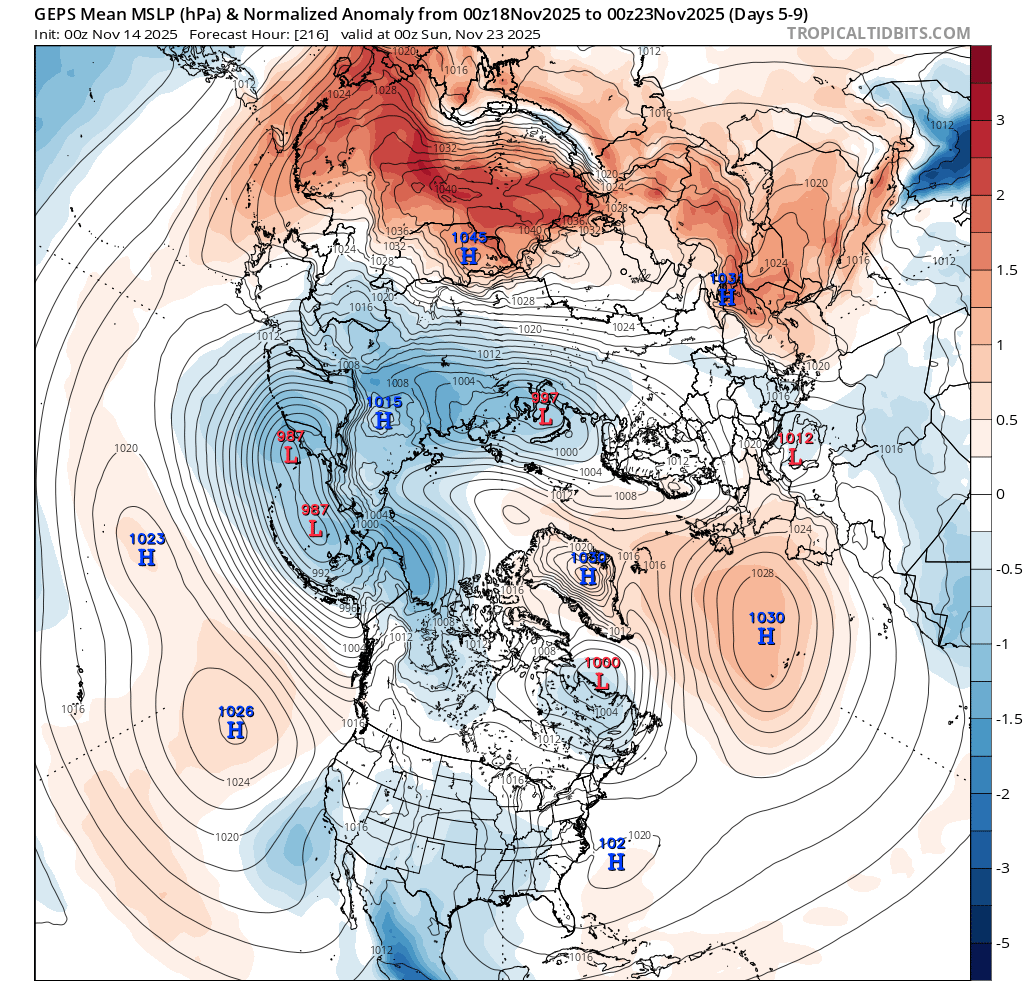
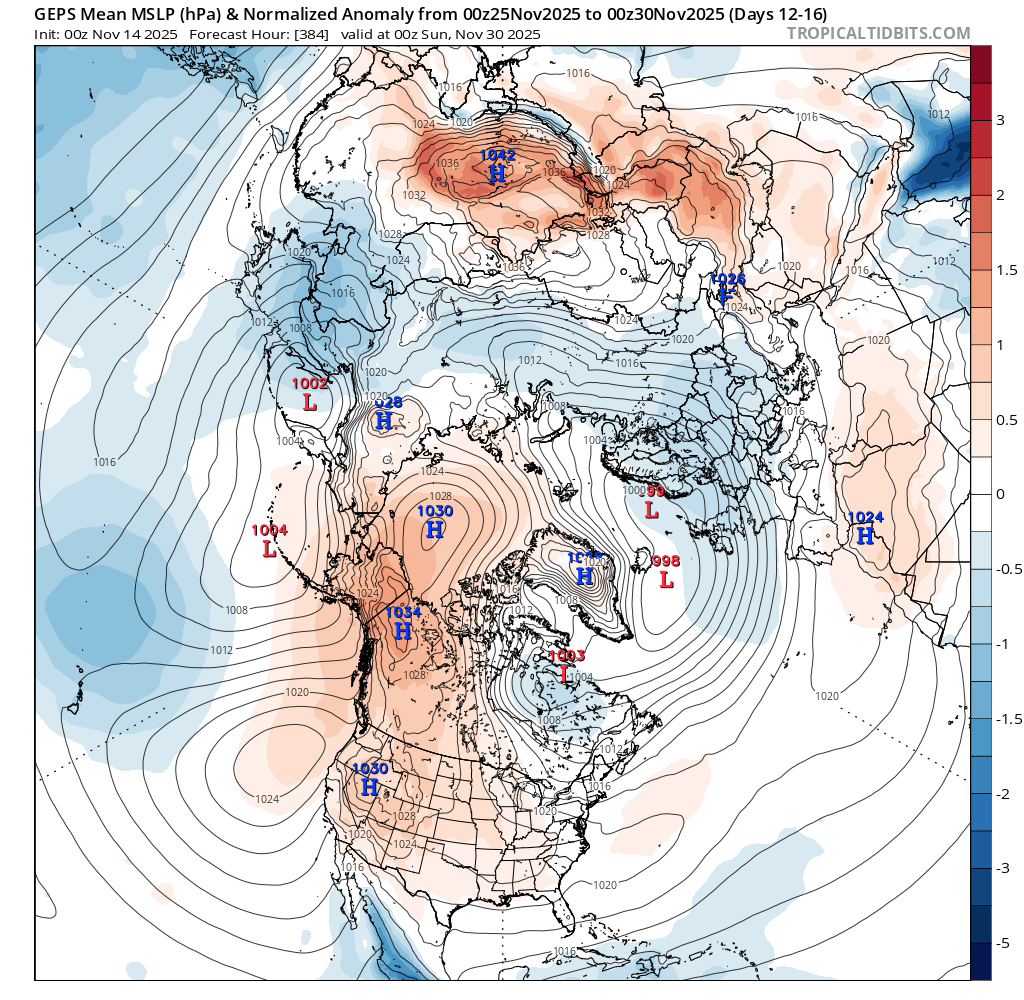
While GEFS,EPS do not show this..
For the continental US the amount of cooling also has very different scenarios for the end of the month. For this comparison I just show det. models for ECMWF/GFS (the ensembles are necessarily less dramatic but this is just for ease of understanding, also CMC doesn't go out that far...)
(Edit: corrected images)
(GEPS, GFS, ECMWF 00Z runs below for same valid time Nov 29/00Z):
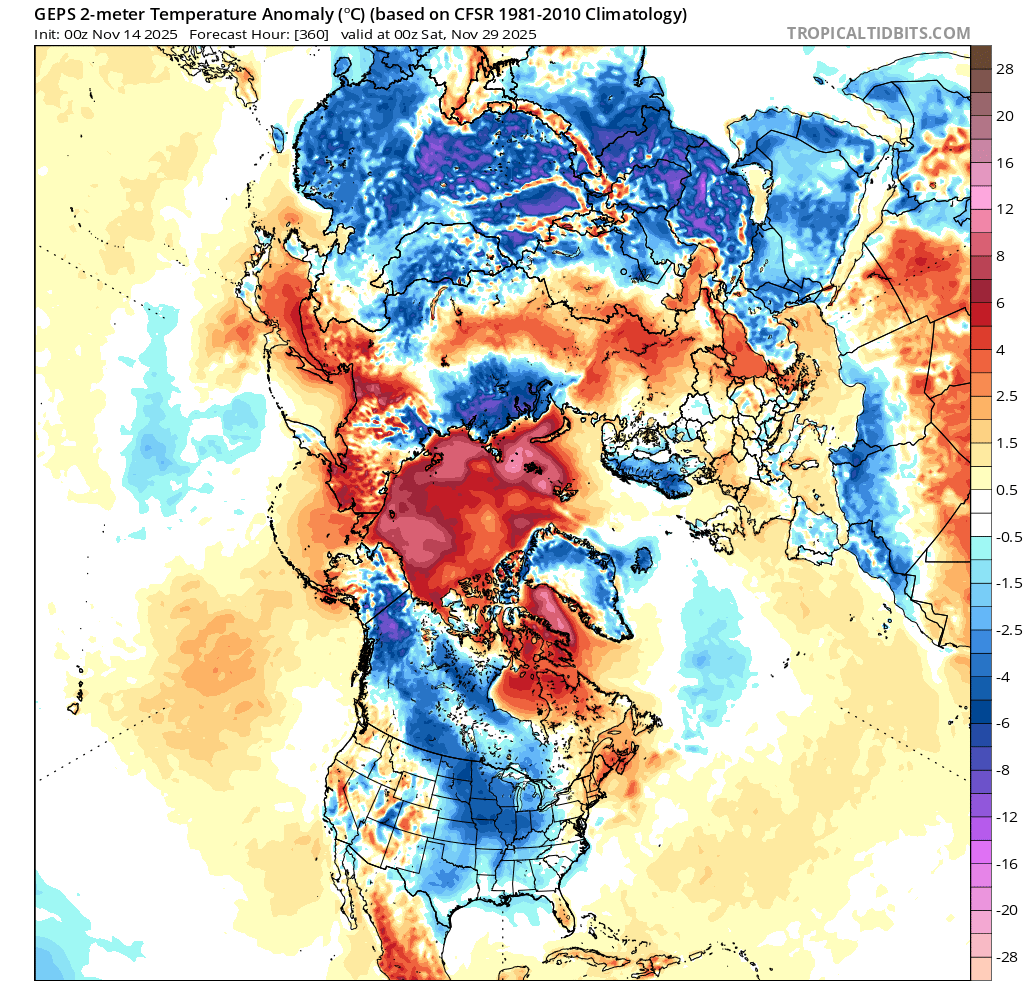

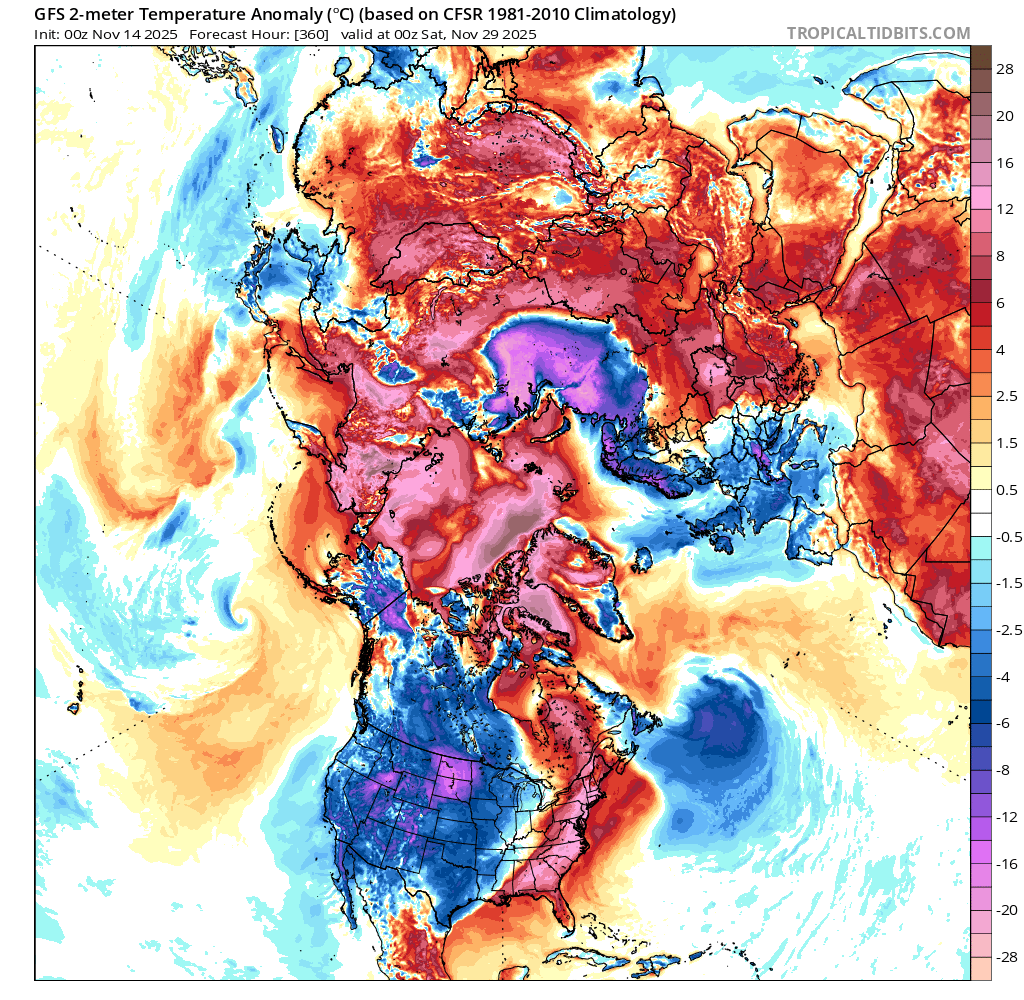
The mid range ensembles for 00Z are only missing the last day or two depending on the ensemble and have already baked most of this temp drop in (minus the last day), but afaik there is still a chance of a false alarm for the SSW in terms of how overdone it results in cooling temps for the end of the november (magnitude and timing).

December is a different story depending on what exactly happens...